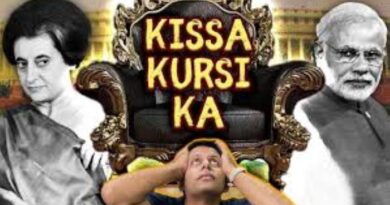Monday Musings: That makes three in a (death) row
You are Here: Tweet, Like, Share, Comment, Subscribe…be the Voice of Free Press!
By Amitabh Srivastava, Edited By Adam Rizvi, The India Observer, TIO: In an atmosphere where ‘an eye for an eye’ seems to be the popular tune, it is almost bizarre to discuss cases where hardened criminals have been released by the highest court of the land on the ground that ‘enough is enough.’
Earlier, the country was discussing two such cases that made headlines this month.
One, the release of the 7-part series The Hunt on Sony Liv, based on the investigation into the assassination of former Prime Minister Rajiv Gandhi on May 21, 1991, where a determined and committed gang of terrorists from the LTTE were involved. While seven of them, including the mastermind Sivarasan, had committed suicide within three months of Rajiv Gandhi’s death, 26 others were awarded death sentences.
By May 1999, 19 of them had been released by the Supreme Court, and of the remaining seven, four had been awarded life terms. On their appeal, the highest court changed the punishment of Nalini to life imprisonment, but the petitions of the others were rejected by the President.
Also Read, Tweet & Share: Are Gandhis equipped for the fight?
Nalini was pregnant at that time, and Sonia Gandhi and Priyanka Gandhi had stated that they did not want a yet-to-be-born child to suffer the consequences of the mother’s action. Later, all of them were released on the ground that they had spent over 31 years in jail, which was deemed enough punishment.
The other case that cropped up in the news this month was that of Sushil Sharma, a former Indian Youth Congress leader who had burnt the body of his wife in a tandoor in a hotel in Connaught Place 30 years back, on July 2, 1995. Sushil Sharma was released from jail after spending 23 years in prison in 2018, even though he had initially been awarded a death sentence, which was later commuted to life imprisonment.
Also Read, Tweet & Share: New Jersey Alliance for Immigrant Justice Condemns Biden’s Executive Order on Asylum as “Betrayal of Trust”
There was total silence from the victims’ families in these two cases, as if the wounds had been healed and they were in a state of selective amnesia.
But now that a third killer, Santosh Singh, who had brutally murdered college student Priyadarshini Mattoo in January 1996, is all set to be released as the Delhi High Court feels he has reformed, it’s a hat-trick of pardons.
Here, however, her brother, Hemant Mattoo, now settled in Canada, is asking questions.
Reliving the horror of the incident three decades ago, where the killer, after chasing her for months, finally battered her skull when she was alone, he asks in a newspaper report,
“What reforms? Has he apologised to my family? Has he apologised to his family? He continues to plead his innocence. What kind of justice is this?”
Also Read, Tweet & Share: RBTC Charts Visionary Roadmap for Muslim Women Multiversity at Lucknow Session
We will know soon whether he gets a reprieve for his good behaviour, or the law listens to the traumatised voice of the family of the victim who was killed when she was 25.
Indian law, with its eccentricities, is notorious for its unpredictability. Different courts in different states have their own interpretations of the same laws. The orders of the lower courts are most of the time not accepted by the High Courts, and the High Court orders are challenged in the Supreme Court and overruled.
But how does the common man—or better still, the common woman—react to these pardons?
This writer spoke to some women who, by virtue of their profession, are both aware of the perpetrators of crimes and closely associated with the victims in this country. But they appear as confused as the rest of us with these arbitrary rulings.
Also Read, Tweet & Share: Challenging NCPCR recommendation to ban Madrasas in India
Incidentally, in the US, which is considered the champion of human rights across the globe, and in some other European countries, criminals are handed terms of 90 years, and even children are sent to jail for up to 30 years. This is not permitted in India under the Juvenile Justice Act.
Suranya Aiyar, a well-known lawyer best recognised for her fight to reunite children snatched away by Child Care Institutions across various countries (she was the real-life lawyer who fought the case of Sagarika Chakraborty in Norway), says,
“I understand and appreciate that the purpose of the Indian legal system is to be compassionate and kind at the end of the day. But sometimes this is stretched too far.”
She mentions the case of the minor involved in the Nirbhaya case, which had sparked a worldwide movement for the victim, who had been raped and her body mutilated. The trial, which was supposed to be a fast-track trial, went on for seven years, after which four were hanged, one committed suicide, but like most of the people in the country, she is not happy with the special treatment given to the minor.
Also Read, Tweet & Share: Monday Musings: Women take over Prayas and no one minds
He was released after his three-year term in a juvenile institute and given a lump sum of money by the government to start a new life.
Indu Rani Singh, Executive Director of Prayas JAC Society, which has been working in rescuing children from child labour, child marriages, and beggary for over 30 years, is shocked by these pardons.
“As a woman, and especially after working in rescue and rehabilitation schemes of children, I am very worried about the impact of such pardons on society. What message are these decisions giving? You commit a heinous crime, execute it after long sinister planning involving international parties as in the Rajiv Gandhi case, and the punishment is only a jail term—even if it’s 30 years—but at the end of it, you are released by the Supreme Court. The culprits who died did so by their own choice, while a suicide bomber and six others committed suicide.”
Also Read, Tweet & Share: Hate Crimes against Muslims have begun in Haryana ahead of Polls
She differentiates these crimes from those committed by juveniles or minors—currently defined as under 18 for heinous crimes as per United Nations and international norms.
“The crimes committed by minors are not planned but mostly spur-of-the-moment reactions driven by emotional reasons. The juvenile law says that the brains of children are not sufficiently developed till 18, and they are not aware of the consequences of their actions. Hence, the Juvenile Justice Boards allow them a ‘second chance’ in life because they have a full life ahead of them,” she says.
Yet another interesting feature of the crime scene is that, in most cases, it’s the wives of the culprits who turn into their best defenders—unless they are themselves the victims.
If well-off, they hire the best lawyers to fight their husbands’ cases. Or, if they are advocates themselves, they fight the cases personally.
Also Read, Tweet & Share: Bilkis Bano plea against remission granted to her convicts will be heard – Justices Ajay Rastogi
In the Bilkis Bano case, 11 convicts were sent to jail for brutal crimes including rape and murders during the 2002 riots in Gujarat. They were imprisoned in 2008. However, in 2022, the new Gujarat government released them, creating shockwaves across the country. These convicts were welcomed with artis by their wives, like heroes returning from war.
Deepshikha Singh, a senior social activist with an NGO who has been working with victims of sexual assaults for over a decade under the Crisis Intervention Centres (now functioning as One-Stop Centers across the country), argues that this behaviour is plain common sense and survival instinct.
“Wives have to support their husbands, especially in India, because living alone for married women remains a stigma. Besides, they are financially dependent in most cases. We don’t have institutions like single mother homes or hostels like in Western countries. Hence, whatever the husband does, the wife has no option but to support him.”
Also Read, Tweet & Share: Taslim Jahan, Rape and Murder Case Go Unsung
Adding, “Even when they are legally empowered, they prefer to play safe to save their marriages. A case in point are the women elected as Gram Panchayat Chiefs. They have been invested with so much power by the Constitution, but a majority of them continue to work behind the ghunghat, allowing their husbands or elders in the family to hog all the limelight.”
Also Read more from this Author: Monday Musings: Futility vs Utility
Curated by Humra Kidwai
Articles written by contributors have different viewpoints. The views expressed in the articles are the author’s own and not necessarily supported by TIO, The India Observer its affiliates, staff, or the management. Our Articles can be reproduced, with the following conditions, (1) No alteration to the content, (2) Visible, and full credit is given to the Author & Editor. (3) Citing, The India Observer, TIO. In the case of online or electronic media, a link to the original article must be given. Rules are strictly enforced. Any questions, email the Editor at: Mediaiss@gmail.com Or TheIndiaObserver@gmail.com




